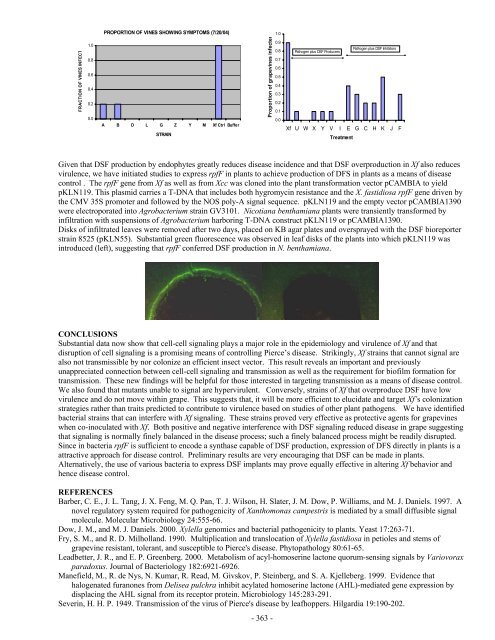Impact Of Host Plant Xylem Fluid On Xylella Fastidiosa Multiplication ...
Impact Of Host Plant Xylem Fluid On Xylella Fastidiosa Multiplication ...
Impact Of Host Plant Xylem Fluid On Xylella Fastidiosa Multiplication ...
You also want an ePaper? Increase the reach of your titles
YUMPU automatically turns print PDFs into web optimized ePapers that Google loves.
FRACTION OF VINES INFECT<br />
1.0<br />
0.8<br />
0.6<br />
0.4<br />
0.2<br />
0.0<br />
PROPORTION OF VINES SHOWING SYMPTOMS (7/20/04)<br />
A B D L G Z Y M Xf Ctrl Buffer<br />
STRAIN<br />
Proportion of grapevines infected<br />
1.0<br />
0.9<br />
0.8<br />
0.7<br />
0.6<br />
0.5<br />
0.4<br />
0.3<br />
0.2<br />
0.1<br />
0.0<br />
Pathogen plus DSF Inhibitors<br />
Pathogen plus DSF Producers<br />
Xf U W X Y V I E G C H K J F<br />
Treatment<br />
Given that DSF production by endophytes greatly reduces disease incidence and that DSF overproduction in Xf also reduces<br />
virulence, we have initiated studies to express rpfF in plants to achieve production of DFS in plants as a means of disease<br />
control . The rpfF gene from Xf as well as from Xcc was cloned into the plant transformation vector pCAMBIA to yield<br />
pKLN119. This plasmid carries a T-DNA that includes both hygromycin resistance and the X. fastidiosa rpfF gene driven by<br />
the CMV 35S promoter and followed by the NOS poly-A signal sequence. pKLN119 and the empty vector pCAMBIA1390<br />
were electroporated into Agrobacterium strain GV3101. Nicotiana benthamiana plants were transiently transformed by<br />
infiltration with suspensions of Agrobacterium harboring T-DNA construct pKLN119 or pCAMBIA1390.<br />
Disks of infiltrated leaves were removed after two days, placed on KB agar plates and oversprayed with the DSF bioreporter<br />
strain 8525 (pKLN55). Substantial green fluorescence was observed in leaf disks of the plants into which pKLN119 was<br />
introduced (left), suggesting that rpfF conferred DSF production in N. benthamiana.<br />
CONCLUSIONS<br />
Substantial data now show that cell-cell signaling plays a major role in the epidemiology and virulence of Xf and that<br />
disruption of cell signaling is a promising means of controlling Pierce’s disease. Strikingly, Xf strains that cannot signal are<br />
also not transmissible by nor colonize an efficient insect vector. This result reveals an important and previously<br />
unappreciated connection between cell-cell signaling and transmission as well as the requirement for biofilm formation for<br />
transmission. These new findings will be helpful for those interested in targeting transmission as a means of disease control.<br />
We also found that mutants unable to signal are hypervirulent. Conversely, strains of Xf that overproduce DSF have low<br />
virulence and do not move within grape. This suggests that, it will be more efficient to elucidate and target Xf’s colonization<br />
strategies rather than traits predicted to contribute to virulence based on studies of other plant pathogens. We have identified<br />
bacterial strains that can interfere with Xf signaling. These strains proved very effective as protective agents for grapevines<br />
when co-inoculated with Xf. Both positive and negative interference with DSF signaling reduced disease in grape suggesting<br />
that signaling is normally finely balanced in the disease process; such a finely balanced process might be readily disrupted.<br />
Since in bacteria rpfF is sufficient to encode a synthase capable of DSF production, expression of DFS directly in plants is a<br />
attractive approach for disease control. Preliminary results are very encouraging that DSF can be made in plants.<br />
Alternatively, the use of various bacteria to express DSF implants may prove equally effective in altering Xf behavior and<br />
hence disease control.<br />
REFERENCES<br />
Barber, C. E., J. L. Tang, J. X. Feng, M. Q. Pan, T. J. Wilson, H. Slater, J. M. Dow, P. Williams, and M. J. Daniels. 1997. A<br />
novel regulatory system required for pathogenicity of Xanthomonas campestris is mediated by a small diffusible signal<br />
molecule. Molecular Microbiology 24:555-66.<br />
Dow, J. M., and M. J. Daniels. 2000. <strong>Xylella</strong> genomics and bacterial pathogenicity to plants. Yeast 17:263-71.<br />
Fry, S. M., and R. D. Milholland. 1990. <strong>Multiplication</strong> and translocation of <strong>Xylella</strong> fastidiosa in petioles and stems of<br />
grapevine resistant, tolerant, and susceptible to Pierce's disease. Phytopathology 80:61-65.<br />
Leadbetter, J. R., and E. P. Greenberg. 2000. Metabolism of acyl-homoserine lactone quorum-sensing signals by Variovorax<br />
paradoxus. Journal of Bacteriology 182:6921-6926.<br />
Manefield, M., R. de Nys, N. Kumar, R. Read, M. Givskov, P. Steinberg, and S. A. Kjelleberg. 1999. Evidence that<br />
halogenated furanones from Delisea pulchra inhibit acylated homoserine lactone (AHL)-mediated gene expression by<br />
displacing the AHL signal from its receptor protein. Microbiology 145:283-291.<br />
Severin, H. H. P. 1949. Transmission of the virus of Pierce's disease by leafhoppers. Hilgardia 19:190-202.<br />
- 363 -











